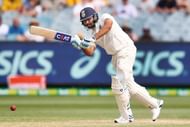It is nothing new for India to dominate teams at home; their players have always excelled while playing on familiar pitches. Overseas teams have struggled against the conditions in India, the players, and sometimes the weather too.
It was starkly evident to everyone that India were superior to South Africa in the recent home series. They dominated in all aspects - right from the win margins and dominant batting performances to killer bowling spells from all bowlers and fielding sharpness.
India have firmly positioned at the top of the ICC ICC World Test Championship table; Virat Kohli's men are well ahead of everyone with 240 points. If you add the points of all the rest of the teams, it would come to just 232 - eight short of India's tally.
Before this series, the last time South Africa lost after being asked to follow on was 17 years ago, against Australia back in 2002. But in this series, India enforced the follow-on twice, and won both of those matches by an innings margin.
India recorded their two biggest victories against South Africa (in terms of innings margin) in this series. In the second Test, their winning margin was innings and 137 runs, which broke the previous record of innings and 57 runs.
Kohli and his men went one level up after that, beating the record again at Ranchi. Now the biggest Indian Test victory over South Africa is by an innings and 202 runs.
The whole South African team could score just 1,381 runs in the series across six innings, losing 60 wickets in the process. Compare this with the total of just four Indian batsmen - Rohit Sharma, Virat Kohli, Mayank Agarwal and Ajinkya Rahane - who amassed 1402 runs, and that too while batting in only four innings.

Moreover, Kohli was not out twice out of his four innings, and Rahane not out once.
The difference was evident in the bowling too. The whole South African bowling attack could muster only 25 wickets. On the other hand, Ravichandran Ashwin and Mohammad Shami shared 28 wickets between them.
India averaged 76.92 with the bat and 23.01 with the ball. The difference between the batting and bowling averages for India was 53.91. In other words, if you consider both batting and bowling together, India added 53.91 average runs per wicket. The dominance was crystal clear.

These numbers don't just serve as confirmation of how good India are in their own backyard. They also reveal a lot about the condition of South African cricket.
To add to the horror numbers, Kabada Rabada's on-field run-in with Quinton de Kock, Rabada's statement about their team being under immense pressure, and Aiden Markram's self-inflicted injury spoke volumes about how much South Africa were mentally and physically drained in the series.
This was a mismatch of epic proportions, and both the numbers and the intangibles bear that out.
Follow Sportskeeda for all the updates on England vs New Zealand head to head, England vs New Zealand schedule 2019, news, results, points table, most runs, most wickets and fantasy tips.
Brand-new app in a brand-new avatar! Download CricRocket for fast cricket scores, rocket flicks, super notifications and much more! 🚀☄️
